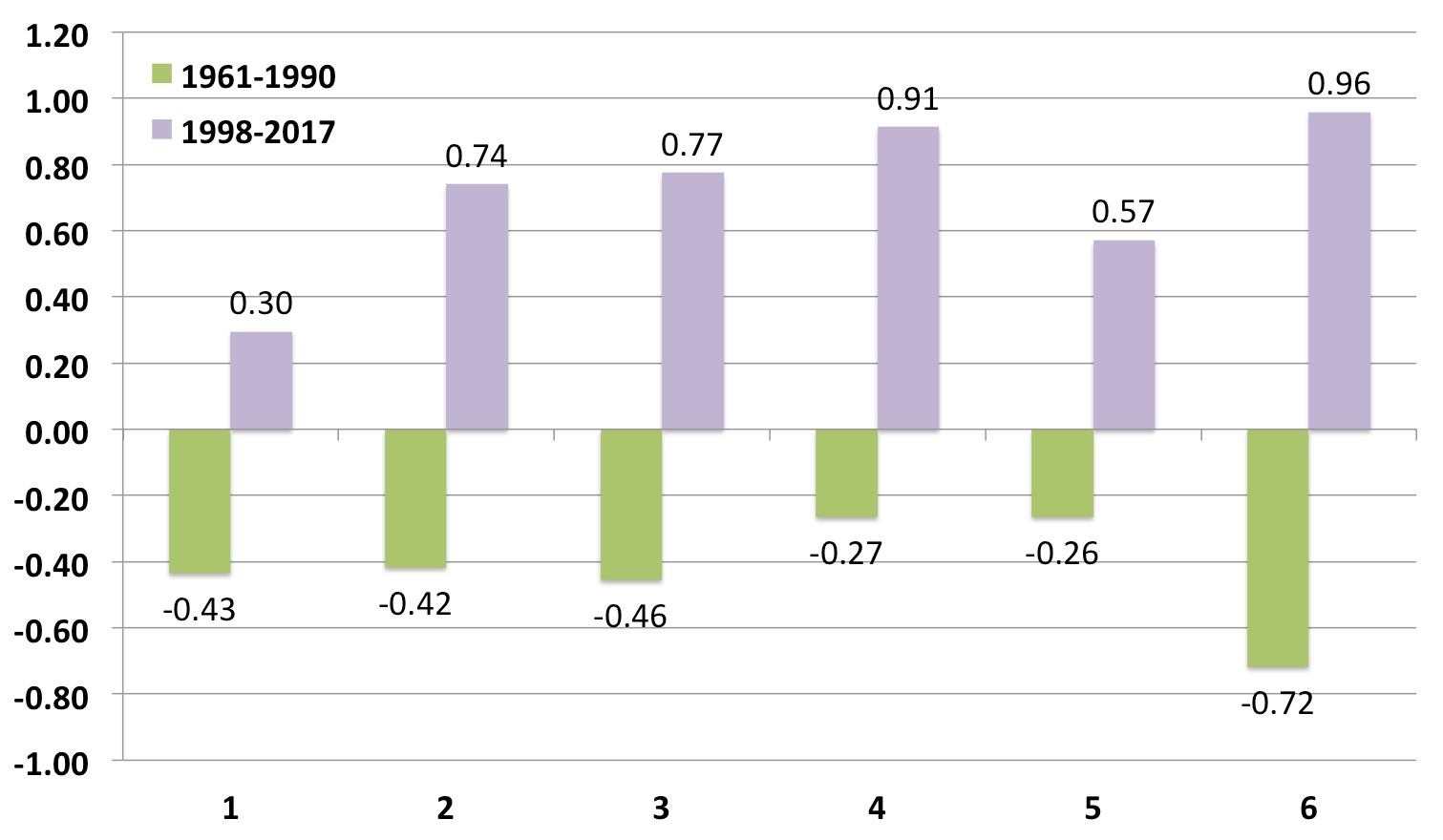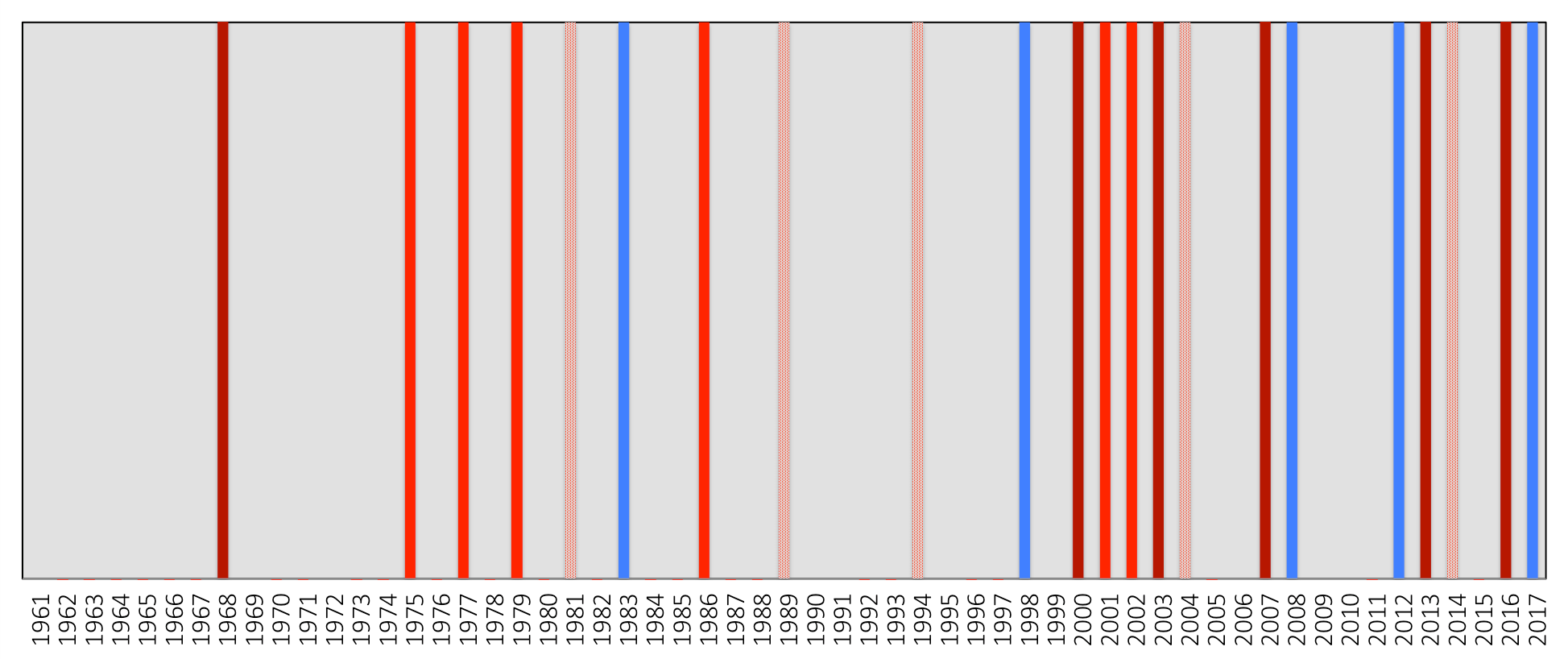Key message: Flowering of Prinus laurocerasus has been more frequent in recent years
Assessment: Blooming of Prunus laurocerasus (Cherry laurel, local name: Zeleniče) was never recorded in the older literature. The first time it was observed and recorded was in 1983. Years when blooming was observed and recorded are: 1983, 1998, 2008, 2012, 2017. For other years occurrence of blooming is unknown. The period during which blooming was observed is May-June. Final set of criteria, which must agree with values derived from temperature data for the first half of the year, generated a result that during the period of 57 years blooming was possible in 17 years, from which 6 happened during the 1961-1990 and other 11 during the period of significantly warmer climate 1998-2017, when relatively frequent blooming of Zeleniče was observed. Last three recorded blooms happened with 4-5 years interval. It remains unknown if blooming occurred meanwhile. One should have in mind there is high probability that Zeleniče at Oštrozub is currently under climate heat conditions that are still not optimal for every year of blooming occurrence, but with future temperature increase, blooming frequency can increase. Analysis of climate conditions was done for the period 1961-2017 for the site where Zeleniče grows on mountain Oštrozub (latitude 42.88694; longitude 22.22361)


Indicator Name: Flowering of Prunus laurocerasus related to Climate Changes
Institution/Author: Faculty of agriculture, University of Belgrade/Dr Ana Vuković, Environmental Protection Agency/Slaviša Popović
Use and interpretation: Flowering of Zeleniče (Prunus laurocerasus) has never been recorded in the older literature. For the first time it was observed and recorded in 1983. Years when flowering was observed and recorded are: 1983, 1998, 2008, 2012, 2017. For other years occurrence of flowering is unknown. Period during which flowering was observed is May-June.
Key question(s) which indicator helps to answer: Flowering phenology of winter aconite caused by climate changes
Use of indicator: To record flowering exact interval of years.
Scale of appropriate use: Approach in finding the criteria, which indicate favourable heat conditions for flowering of Zeleniče that is possible to occur in the period May-June but depends on heat conditions before flowering occurrence as well, is based on setting the criteria using threshold values, which are defined using the values obtained for years for which was observed and recorded flowering.
Potential for aggregation:
Meaning of upward or downward trends (“good or bad”): appearance of flowering and more frequent appearance, which was absent in the past; good because of increased reproduction potential and survival of endangered species
Possible reasons for upward or downward trends: increase of temperature and suitable heat conditions for flowering
Implications for biodiversity management of change in the indicator: positive side of changes is survival of species and enrichment of natural ecosystem; suggestion for management of the change of indicator is regular flowering observations and protection from extermination, and placement of measurement station (at least air temperature at 2m altitude).
Units in which it is expressed:
occurrence of flowering (yes or no)
Description of source data:
years when flowering is detected at Oštrozub, about 1 ha (SEPA observations, available observation are not continuous, information are also collected from the literature); temperature data are interpolated from available RHMSS stations, including impact of altitude.
Calculation procedure:
method for determining relation with temperature includes calculation of heat conditions (anomalies of average temperature and sum of the active temperatures for biological minimum 10° for the period relevant for flowering) using interpolated temperature data from RHMSS stations for the period 1961-2017; constraints: verification of method for continuous data is desired, which currently are not available, and availability of “at site” measurements of meteorological data (at least 2m alt. air temperature data), which is the reason for using anomalies instead absolute values
Most effective forms of presentation:
graphs and narrative, example:

Occurrence of suitable heat conditions for flowering obtained with methodology, including years when flowering occurrence is observed: Years of analysed period 1961-2017, which satisfy heat criteria for flowering of Zeleniče: blue lines – flowering was also recorded, light red lines – heat criteria K1 and K2 are satisfied, but not K3 (minimum criteria satisfied), red lines – K1, K2, K3 are satisfied (full criteria satisfied), dark red lines – K1, K2, K3 are satisfied, but K1 is satisfied for two out of four months (not one as required, stronger criteria satisfied).
Limits to usefulness and accuracy:
locality of the indicator is deep in the natural forest, not suitable for regular (daily) observations, to be able to record the date of flowering if it occurs; no nearby meteorological measurement stations
Updating the indicator:
best is to have observations of flowering each year on regular basis from May (maybe April) to July in order to record date of flowering; if not possible, then to record each year if flowering occurred or not
Closely related indicators flowering of other plan species and shift in their flowering date (or dates of other phenophase)
Additional information and comments: Zeleniče (Prunus laurocerasus var Serbica) is tertiary relict that survived ice age within beech forest at Oštrozub mountain in Serbia (1200-1300m altitude). Flowering has never been recorded until 1983. During the recent years (which are among top warmest for Serbia) flowering in several years has been recorded. Behaviour of flowering shows close relation to warmer climate conditions.
Serbia